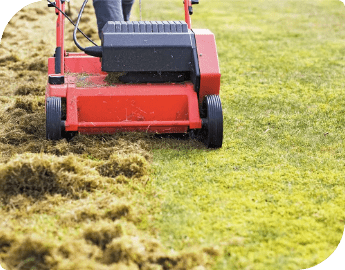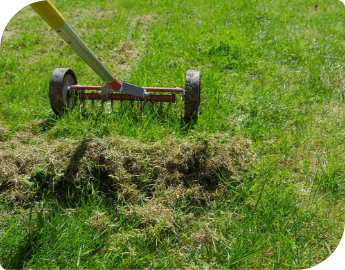Is scarifying a lawn worth it?
Yes, scarifying a lawn is highly worth it, particularly if your lawn suffers from moss and thatch buildup. This invasive but beneficial process gives the grass space to grow, improves its access to nutrients and water, and restores its wellbeing. It also helps to minimize your lawn's susceptibility to diseases and pests, leaving no traces of thatch, moss, or weeds, but only a thriving, healthier, and lusher lawn than ever, making it a valuable long-term investment.
What does a lawn look like after scarifying?
After scarifying, it's normal for your lawn to look a bit bare or patchy. This is because the process mechanically removes a significant amount of thatch, moss, and dead organic matter from the surface. While it might appear untidy immediately after the service, this is only temporary. With regular watering and proper aftercare, such as overseeding and top-dressing, your lawn will recover and look healthier and lusher than ever within 8-12 weeks, as the grass gets space to grow.
Can I book lawn scarification during winter?
We usually don't do scarification in winter because winter conditions can damage your lawn if scarification is performed.
Should you mow before scarifying?
Yes, it is recommended that your lawn is freshly mowed before the scarification service. This practice allows the scarifier's blades or flails to reach the thatch and moss layer more effectively, ensuring that more of the unwanted material is extracted from the lawn. It also contributes to a more efficient and uniform scarification process, leading to better overall results for your lawn's recovery and health.
How many times should you go over the lawn with a scarifier?
The number of passes you should make over a lawn with a scarifier depends on the desired intensity of the treatment and the season. For heavy lawn scarification, typically performed in autumn, gardeners will scarify your lawn several times, often at right angles, to ensure all the thatch and moss are thoroughly removed. In spring, a single pass is generally recommended as the recovery of your lawn can take longer. Our experienced gardeners decide the appropriate method for your lawn.
Are lawn raking and scarification the same thing?
No, raking is carried out by using a small raking machine and can deal only with the moss. Scarification is done by using a manual or motorised machine with flails, usually made of steel. It’s a rather invasive treatment to the lawn, hence the need of a recovery time. Using a scarifier helps eliminate the reason behind moss build-up, namely thatch.
What to do immediately after scarifying a lawn?
Immediately after scarifying a lawn, it's essential to clear up all the generated thatch and moss, as this material can hinder new grass growth. Our gardeners will clear up your lawn and can even take care of its disposal upon request, including disposing of up to 120 liters of thatch for free. Following this, it is highly recommended to overseed any bare or thin patches, apply a suitable fertilizer, and water the lawn regularly to support its recovery and promote new growth.
How long after scarifying should I overseed?
You should overseed your lawn immediately after scarifying. This timing is ideal because scarification opens up the soil surface, creating excellent seed-to-soil contact, which is crucial for successful germination and establishment of new grass. The removed thatch and moss also leave more space for new seedlings to grow. Following scarification with overseeding, along with regular watering, is key to revitalizing your lawn and achieving a denser, healthier turf.
What is the best fertiliser after scarifying?
After scarifying, it's beneficial to apply a balanced, slow-release fertiliser that supports new grass growth and helps the lawn recover quickly. A fertiliser with a higher nitrogen content can promote green-up and leaf growth, while balanced NPK (Nitrogen, Phosphorus, Potassium) ratios ensure overall root and shoot development. We also recommend overseeding and top-dressing your lawn after scarification to get even better results and ensure your lawn becomes healthier and lusher than ever.
How to revive a lawn after scarifying?
To revive a lawn after scarifying and help it recover, regular watering is crucial to support new growth, especially during the 8-12 week recovery period. Our service also recommends overseeding and top-dressing your lawn. Overseeding introduces new grass, while top-dressing adds nutrients and improves soil structure. These steps combined with consistent care will help your lawn become healthier and lusher than ever, ensuring it benefits greatly from the scarification treatment.
Will grass grow back after scarifying?
Yes, grass will definitely grow back after scarifying. Although the lawn may look a bit patchy or bare immediately after the service, this is a normal and temporary stage of the process. Scarification is performed when the grass is actively growing to ensure quick recovery. With proper aftercare, including regular watering, overseeding, and top-dressing, your lawn will recover within 8-12 weeks, becoming healthier, denser, and lusher than ever.
Does scarifying a lawn remove weeds?
Yes, scarifying a lawn does help to remove weeds, particularly shallow-rooted varieties that are pulled out along with the thatch and moss during the process. While it may not eliminate all types of weeds, by reducing the dense thatch layer and improving the overall health of the grass, scarification also creates a less hospitable environment for weeds to thrive, further contributing to a cleaner and healthier lawn.
Will scarifying help level a lawn?
Scarifying a lawn is a process specifically designed to remove thatch and moss from the grass surface, not to level the underlying soil or address uneven ground. While the removal of large clumps of moss might make very minor surface irregularities less noticeable, scarification does not redistribute soil or fill in depressions to truly level a lawn. For leveling issues, other landscaping services like top-dressing or grading would be required.
When can I book lawn scarification service with you?
You can book the lawn scarification service all-year round, but we usually carry this work during the out-of-season period (late autumn and early spring). This will allow your lawn to recover and be green for the active outdoor season.
Do you collect the thatch after the service?
Upon request, we can clear your lawn and put the thatch onto your compost heap. We can also dispose of up to 120l of thatch for free. More waste can be removed for an extra fee.



